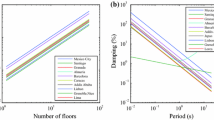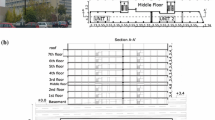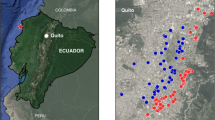Abstract
This paper estimates fundamental translational period and damping ratio parameters and examines the changes in dynamic characteristics of a set of low-to-medium rise buildings in Lorca town (SE of Spain) affected by the May 11th, 2011 earthquake. These building parameters have been calculated analysing structural dynamic response from ambient vibration measurements recorded at top RC buildings pre- and post earthquake, using the Fast Fourier Transform and the Randomdec technique. The empirical expression relating period \((T)\) and number of floor \((N)\) here obtained analysing ambient noise recorded on 59 healthy buildings before the earthquake is \(T= (0.054\pm 0.002)\, N\), very similar to others empirical period–height relationships obtained for RC structures in the European built environment but quite different from code provisions. Measurements performed in 34 damaged buildings show a period elongation after the quake according to \(T^{*} =(0.075\pm 0.002)\,N\) expression. Moreover, we found a rise of the fundamental period with the EMS’s grade of damage of buildings. In contrast to natural frequency, damping ratio \((\xi )\) do not shows a significant variation with earthquake damage degree and the product \(\xi \, T\) remains near constant.






Similar content being viewed by others
References
Baptista AJ, Oliveira CS (2004) Aferição de Modelos Estruturais de Edifícios Correntes com Base em Medições in situ de Frequências Próprias. 5th Portuguese Conference on Earthquake Engineering, Universidade do Minho (in Portuguese)
Calvi GM, Pinho R, Crowley H (2006) State-of the-knowledge on the period elongation of RC buildings during strong ground shaking. In: First European conference on earthquake engineering and seismology, Geneva, 3–8 Sept 2006, Paper Number 1535
Carydis P, Mouzakis HP (1986) Small amplitude vibration measurements of buildings undamaged, damaged, and repaired after earthquakes. Earthq Spectra 2(3):515–535
CEN (2005) Eurocode 8. Design of structures for earthquake resistance. Part 1: general rules, seismic actions and rules for buildings, European Committee for standardization, Brussels
Cole HA (1968) On-the-line analysis of random vibrations. In: AIAA/ASME 9th structural dynamics materials conference, Palm Spring, CA
Consuegra F, Irfanoglu A (2012) Variation of small amplitude vibration dynamic properties with displacement in reinforced concrete structures. Exp Mech. doi:10.1007/s11340-011-9590-0
Ditommaso R, Parolai S, Mucciarelli M, Eggert S, Sobiesiak M, Zschau J (2010) Monitoring the response and the back-radiated energy of a building subjected to ambient vibration and impulsive action: the Falkenhof Tower (Potsdam, Germany). Bull Earthq Eng 8(3). doi:10.1007/s10518-009-9151-4
Dunand F, Bard P-Y, Chatelain JL, Guéguen Ph, Vassail T, Farsi MN (2002) Damping and frequency from randomdec method applied to in-situ measurements of ambient vibrations: evidence for effective soil structure interaction. In: 12th European conference on earthquake engineering. Elsevier Science Ltd., Paper reference 869, CD-ROM, London
EMS-98, European Macroseismic Scale, Grünthal G (ed) (1998) Cahiers du Centre Européen de Géodynamique et de Séismologie, 7, Luxembourg, p 99
Enomoto T, Schmitz M, Abeki N, Masaki K, Navarro M, Rocavado V, Sanchez A (2000) Seismic risk assessment using soil dynamics in Caracas, Venezuela. In: 12th WCEE, CD-ROM
Farrar CR, Doebling SW, Nix DA (2001) Vibration-based structural damage identification. Philos Trans Roy Soc Lond A 359:131–149
Gallipoli MR, Mucciarelli M, Vona M (2009) Empirical estimate of fundamental frequencies and damping for Italian buildings. Earthq Eng Struct Dyn 38:973–988
Gallipoli MR, Mucciarelli M, Šket-Motnikar B, Zupanćić P, Gosar A, Prevolnik S, Herak M, Stipčević J, Herak D, Milutinović Z, Olumćeva T (2010) Empirical estimates of dynamic parameters on a large set of European buildings. Bull Earthq Eng 8:593–607
Goel RK, Chopra AK (1997) Period formulas for moment-resisting frame buildings. Struct Eng Div ASCE 123:1454–1461
Kobayashi H, Midorikawa S, Tanzawa H, Matsubara M (1987) Development of portable measurement system for ambient vibration test of building. J Struct Constr Eng (Transactions of Architectural Institute of Japan) 378:48–56
Kobayashi H, Vidal F, Feriche M, Samano T, Alguacil G (1996) Evaluation of dynamic behaviour of building structures with microtremors for seismic microzonation mapping. In: The 11th world conference on earthquake engineering, Acapulco, México, 23–28 June 1996
Lagomarsino S (1993) Forecast models for damping and vibration periods of buildings. J Wind Eng Ind Aerodyn 48:221–239
Lin CP (1981) The measurement of damping and natural frequencies in linear systems by using the Random Decrement Technique. M.S. Thesis, University of Maryland
Masi A, Vona M (2008) Estimation of the period of vibration of existing RC building types based on experimental data and numerical results. Springer book, WB/NATO publishing unit, increasing seismic safety by combining engineering technologies and seismological sata, pp 207–226
Masi A, Vona M (2010) Experimental and numerical evaluation of the fundamental period of undamaged and damaged RC framed buildings. Bull Earthq Eng 8:643–656. doi:10.1007/s10518-009-9136-3
Midorikawa S (1990) Ambient vibration tests of buildings in Santiago and Viña del Mar. A report on the Chile-Japan joint study project on seismic design of structures, The Japan international co-operation agency
Morita K, Teshigawara M (2004) Damage identification and estimation of buildings through measurements. In: Proceedings of the 13th world conference on earthquake engineering, Vancouver, BC, Canada, 2004. Paper No. 733
Mucciarelli M, Gallipoli MR (2007) Non-parametric analysis of a single seismometric record to obtain building dynamic parameters. Ann Geophys 50:259–266
Navarro M, Sánchez FJ, Feriche M, Vidal F, Enomoto T, Iwatate T, Matsuda I, Maeda T (2002) Statistical estimation for dynamic characteristics of existing buildings in Granada, Spain, using microtremors. Structural Dynamics, Eurodyn 2002, 1, 807–812, Balkema
Navarro M, Vidal F, Feriche M, Enomoto T, Sanchez FJ, Matsuda I (2004) Expected ground RC building structures resonance phenomena in Granada city (southern Spain). In: Proceedings of the 13th world conference on earthquake engineering, Vancouver, BC, Canada, 2004. Paper No. 3308
Navarro M, Oliveira CS (2005) Dynamic properties of existing RC buildings using measurements of ambient vibrations. Structural Dynamics, Eurodyn 2005, 3, 1847–1852, Millpress
Navarro M, Oliveira CS (2006) Experimental techniques for assessment of dynamic behaviour of buildings. In: Oliveira CS, Roca A, Goula X. Assessing and managing earthquake risk. Volume 2, part II, chapter 8, Springer, pp 159–183
Navarro M, Vidal F, Enomoto T, Alcalá FJ, Sánchez FJ, Abeki N (2007) Analysis of site effects weightiness on RC building seismic response. The Adra (SE Spain) example. Earthq Eng Struct Dyn 36:1363–1383
NCSE-02 (2002). Normativa de Construcción Sismorresistente Española. Comisión Permanente de Normas Sismorresistentes. Real Decreto 997/2002. Boletín Oficial del Estado No. 244, Spain, 11 Oct 2002
NHERP (1994) Recommended provisions for the development of seismic regulations for newbuildings. Building Seismic Safety Council, Washington
NZSEE (2006) Assessment and improvement of the structural performance of buildings in earthquakes, recommendations of a NZSEE study group on earthquake risk buildings
Omori F (1922) The semi-destructive earthquake of April 26, 1922. Seismological Notes (Imperial Earthquake Investigation Committee) 3:1–30
Oliveira CS, Navarro M (2010) Fundamental periods of vibration of RC buildings in Portugal from in-situ experimental and numerical techniques. Bull Earthq Eng 8:609–642
Picozzi M, Milkereit C, Zulfikar C, Fleming K, Ditommaso R, Fischer J, Safak E, Özel O, Apaydin N (2010a) Wireless technologies for the monitoring of strategic civil infrastructures: an ambient vibration test on the Fatih Sultan Mehmet suspension bridge in Istanbul, Turkey. Bull Earthq Eng 8(3):671–691
Picozzi M, Ditommaso R, Parolai S, Mucciarelli M, Milkereit C, Sobiesiak M, Di Giacomo D, Gallipoli MR, Pilz M, Vona M, Zschau J (2010b) Real time monitoring of structures in task-force missions: the example of the Mw = 6.3 Central Italy Earthquake, April 6, 2009. Natural Hazards 52(2)/Feb 2010. doi:10.1007/s11069-009-9481-1
Ponzo FC, Ditommaso R, Auletta G, Mossucca A (2010) A fast method for structural health monitoring of Italian reinforced concrete strategic buildings. Bull Earthq Eng 8:1421–1434
Prieto GA, Lawrence JF, Chung AI, Kohler MD (2010a) Impulse response of civil structures from ambient noise analysis. Bull Seism Soc Am 100(5A):2322–2328. doi:10.1785/0120090285
Pugno N, Surace C, Ruotolo R (2000) Evaluation of the non-linear dynamic response to harmonic excitation of a beam with several breathing cracks. J Sound Vib 235:749–762
Salawu OS (1997) Detection of structural damage through changes in frequency: a review. Eng Struct 19(9):718–723
Satake N, Suda K, Arakawa T, Sasaki A, Tamura Y (2003) Damping evaluation using full-scale data of buildings in Japan. J Struct Eng ASCE 129(4):470–477
Snieder R, Hubbard S, Haney M, Bawden G, Hatchell P (2007) Advanced non-invasive geophysical monitoring techniques. Ann Rev Earth Planet Sci 35:653–683
Tamura Y, Sasaki A, Tsukagoshi H (1993) Evaluation of damping ratios of randomly excited buildings using the random decrement technique. J Struct Constr AIJ 454:29–38
Todoroska MI, Trifunac MD (2007) Earthquake damage detection in the imperial county services building I: the data and time-frequency analysis. Soil Dyn Earthq Eng 27:564–576
Trifunac MD, Ivanovic SS, Todorovska MI (2001a) Apparent periods of a building. II: time-fourier analysis. J Struct Eng 127(5):517–526
Trifunac MD, Ivanovic SS, Todorovska MI (2001b) Apparent periods of a building. II: time-frequency analysis. J Struct Eng 127(5):527–537
Verderame GM, Iervolino I, Manfredi G (2010) Elastic period of sub-standard reinforced concrete moment resisting frame buildings. Bull Earthq Eng 8:955–972
Yang JCS, Caldwell DW (1976) Measurement of damping and the detection of damages in structures by the random decrement technique. 46th Shock and Vibration, Bulletin, pp 129–136
Yang JCS, Dagalakis NG (1980) Detection of incipient failure in structure using random decrement technique. In: Proceeding of the fall meeting of society of experimental stress analysis (SESA). Ft Laurdedale, Florida, p 43
Yang JCS, Aggour MS, Al-Sanad H (1982) Application of the random decrement technique in the determination of damping of soils. 7th ECEE
Zhang Z, Cho Ch (2009) Experimental study on damping ratios of in-situ buildings. World Acad Sci Eng Technol 50:614–618
Zembatya Z, Kowalskia M, Pospisilb S (2006) Dynamic identification of a reinforced concrete frame in progressive states of damage. Eng Struct 28:668–681
Acknowledgments
The authors wish to express their sincere gratitude to all those who helped them during the two building measurements surveys, especially to local Civil Protection people of Lorca town and to the engineering company DG (Decisiones Geoconstructivas S.L.) who provided us with numerous building data. Thanks are due to anonymous reviewers for comments and suggestions that helped to improve the manuscript. This research was carried out within the framework of research coordinated projects CGL2007-66745-C02-01-02/BTE, and CGL2011-30187-C02-01-02 funded by the Spanish Ministry of Science and Innovation and Seismomed project funded by Corporación Tecnológica de Andalucía (Spain).
Author information
Authors and Affiliations
Corresponding author
Rights and permissions
About this article
Cite this article
Vidal, F., Navarro, M., Aranda, C. et al. Changes in dynamic characteristics of Lorca RC buildings from pre- and post-earthquake ambient vibration data. Bull Earthquake Eng 12, 2095–2110 (2014). https://doi.org/10.1007/s10518-013-9489-5
Received:
Accepted:
Published:
Issue Date:
DOI: https://doi.org/10.1007/s10518-013-9489-5




